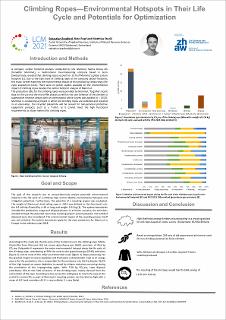Please use this identifier to cite or link to this item:
https://doi.org/10.21256/zhaw-23726Full metadata record
| DC Field | Value | Language |
|---|---|---|
| dc.contributor.author | Bradford, Sebastian | - |
| dc.contributor.author | Rupf, Reto | - |
| dc.contributor.author | Stucki, Matthias | - |
| dc.date.accessioned | 2021-12-11T12:58:05Z | - |
| dc.date.available | 2021-12-11T12:58:05Z | - |
| dc.date.issued | 2021-09-05 | - |
| dc.identifier.uri | https://digitalcollection.zhaw.ch/handle/11475/23726 | - |
| dc.description.abstract | Mountain sports are affected by climate change in a way which few other sports are. Melting glaciers, less snowfall in many regions and rock fall due to thawing permafrost have a direct impact on athletes and businesses around mountain sports. On the other hand, mountain sports also contribute to climate change with greenhouse gas emissions arising from the production chain of sports equipment. We examined the life cycle environmental impact of climbing ropes, from the production chain to the usage and the disposal, produced and sold by the Mammut Sports Group. In addition to the global warming potential (GWP) using the IPCC 2013 method, other impact categories, such as eutrophication or acidification, were assessed using the environmental footprint method. Furthermore, a socio-economic research methodology was used with an online survey in order to obtain data on the rope use and its end-of-life phase, as well as to evaluate the potential of a rope material recycling project by Mammut. The recycled polyamide can be reused for non-personal protective equipment products, such as T-shirts. The results show that the production of the base material polyamide 6 has at 50% the highest impact on the total GWP of 46.6 kg CO2-eq. per climbing rope with 70m length and a weight of 3.54 kg. The raw material production dominates also most other environmental impact categories. Considering the rest of the production chain, the rope processing contributes 18% to the GWP. The emissions are caused by energy intensive processes such as braiding and twining, powered mainly by coal-based electricity. A switch to photovoltaic electricity could reduce the GWP of this supply chain process by 75%. The survey indicated a high willingness of climbers to return their ropes for the purpose of recycling. If all old ropes stored at home or being used for non-climbing purposes in Switzerland were to be recycled, 1170 t CO2-eq. could be saved by substituting primary material and avoiding waste incineration. | de_CH |
| dc.language.iso | en | de_CH |
| dc.publisher | ZHAW Zürcher Hochschule für Angewandte Wissenschaften | de_CH |
| dc.rights | Licence according to publishing contract | de_CH |
| dc.subject | Climbing rope | de_CH |
| dc.subject | Polyamide | de_CH |
| dc.subject | Life cycle assessment | de_CH |
| dc.subject | LCA | de_CH |
| dc.subject | Product development | de_CH |
| dc.subject | Outdoor activities | de_CH |
| dc.subject | Mountaineering | de_CH |
| dc.subject | User behaviour | de_CH |
| dc.subject | Greenhouse gas emissions | de_CH |
| dc.subject.ddc | 338.927: Umweltökonomie und nachhaltige Entwicklung | de_CH |
| dc.title | Climbing ropes : environmental hotspots in their life cycle and potentials for optimization | de_CH |
| dc.type | Konferenz: Poster | de_CH |
| dcterms.type | Text | de_CH |
| zhaw.departement | Life Sciences und Facility Management | de_CH |
| zhaw.organisationalunit | Institut für Umwelt und Natürliche Ressourcen (IUNR) | de_CH |
| dc.identifier.doi | 10.21256/zhaw-23726 | - |
| zhaw.conference.details | Life Cycle Management (LCM) 2021, Stuttgart, Germany, 5-8 September 2021 | de_CH |
| zhaw.funding.eu | No | de_CH |
| zhaw.originated.zhaw | Yes | de_CH |
| zhaw.publication.status | publishedVersion | de_CH |
| zhaw.publication.review | Peer review (Abstract) | de_CH |
| zhaw.webfeed | Ökobilanzierung | de_CH |
| zhaw.author.additional | No | de_CH |
| zhaw.display.portrait | Yes | de_CH |
| Appears in collections: | Publikationen Life Sciences und Facility Management | |
Files in This Item:
| File | Description | Size | Format | |
|---|---|---|---|---|
| 2021_Bradford_Climbing_Ropes.pdf | 448.5 kB | Adobe PDF |  View/Open |
Show simple item record
Bradford, S., Rupf, R., & Stucki, M. (2021, September 5). Climbing ropes : environmental hotspots in their life cycle and potentials for optimization. Life Cycle Management (LCM) 2021, Stuttgart, Germany, 5-8 September 2021. https://doi.org/10.21256/zhaw-23726
Bradford, S., Rupf, R. and Stucki, M. (2021) ‘Climbing ropes : environmental hotspots in their life cycle and potentials for optimization’, in Life Cycle Management (LCM) 2021, Stuttgart, Germany, 5-8 September 2021. ZHAW Zürcher Hochschule für Angewandte Wissenschaften. Available at: https://doi.org/10.21256/zhaw-23726.
S. Bradford, R. Rupf, and M. Stucki, “Climbing ropes : environmental hotspots in their life cycle and potentials for optimization,” in Life Cycle Management (LCM) 2021, Stuttgart, Germany, 5-8 September 2021, Sep. 2021. doi: 10.21256/zhaw-23726.
BRADFORD, Sebastian, Reto RUPF und Matthias STUCKI, 2021. Climbing ropes : environmental hotspots in their life cycle and potentials for optimization. In: Life Cycle Management (LCM) 2021, Stuttgart, Germany, 5-8 September 2021. Conference poster. ZHAW Zürcher Hochschule für Angewandte Wissenschaften. 5 September 2021
Bradford, Sebastian, Reto Rupf, and Matthias Stucki. 2021. “Climbing Ropes : Environmental Hotspots in Their Life Cycle and Potentials for Optimization.” Conference poster. In Life Cycle Management (LCM) 2021, Stuttgart, Germany, 5-8 September 2021. ZHAW Zürcher Hochschule für Angewandte Wissenschaften. https://doi.org/10.21256/zhaw-23726.
Bradford, Sebastian, et al. “Climbing Ropes : Environmental Hotspots in Their Life Cycle and Potentials for Optimization.” Life Cycle Management (LCM) 2021, Stuttgart, Germany, 5-8 September 2021, ZHAW Zürcher Hochschule für Angewandte Wissenschaften, 2021, https://doi.org/10.21256/zhaw-23726.
Items in DSpace are protected by copyright, with all rights reserved, unless otherwise indicated.